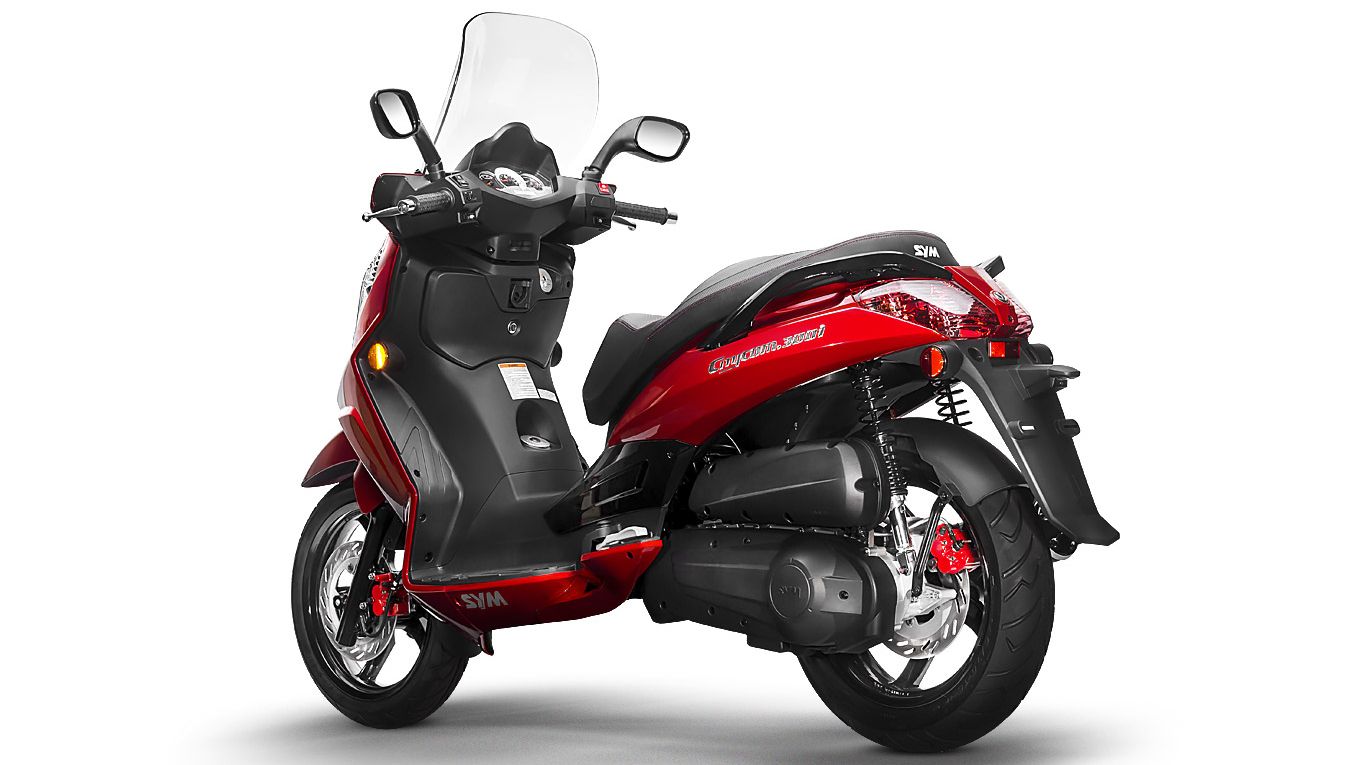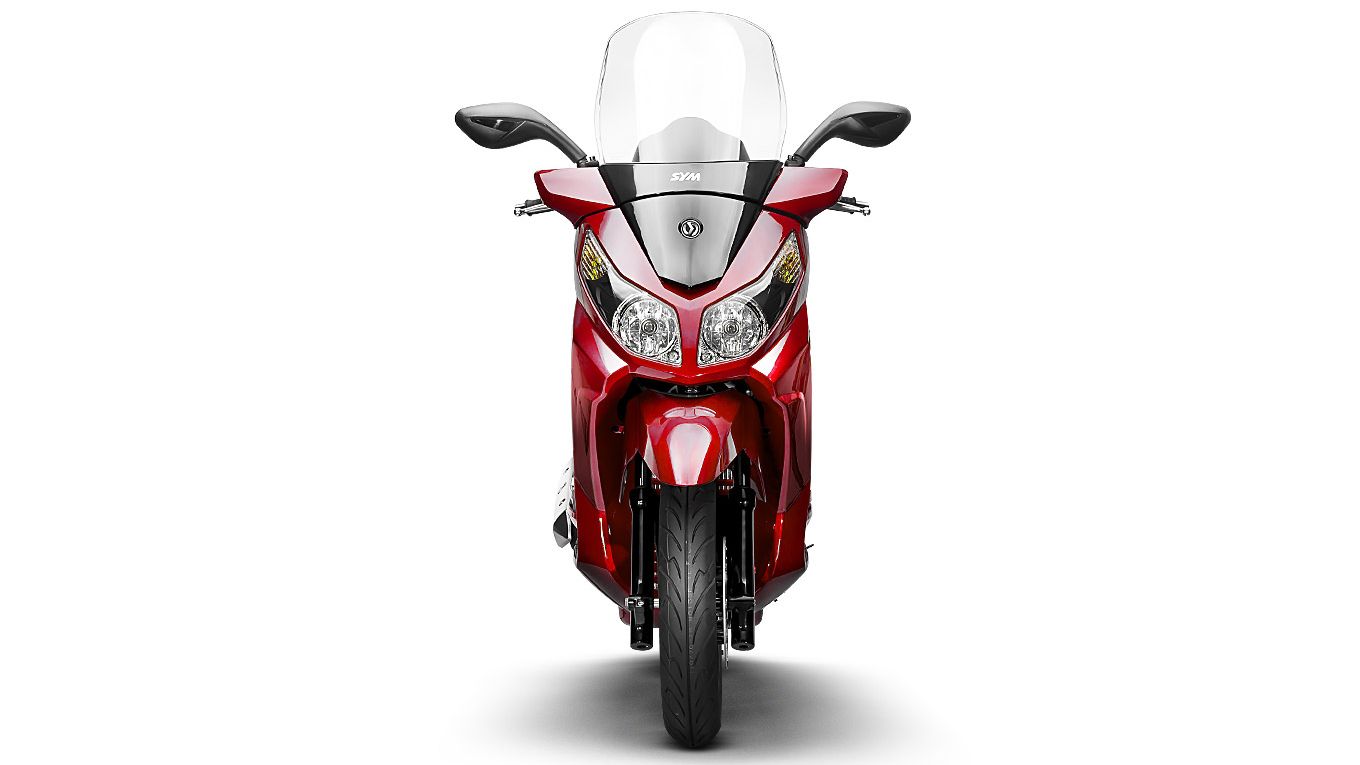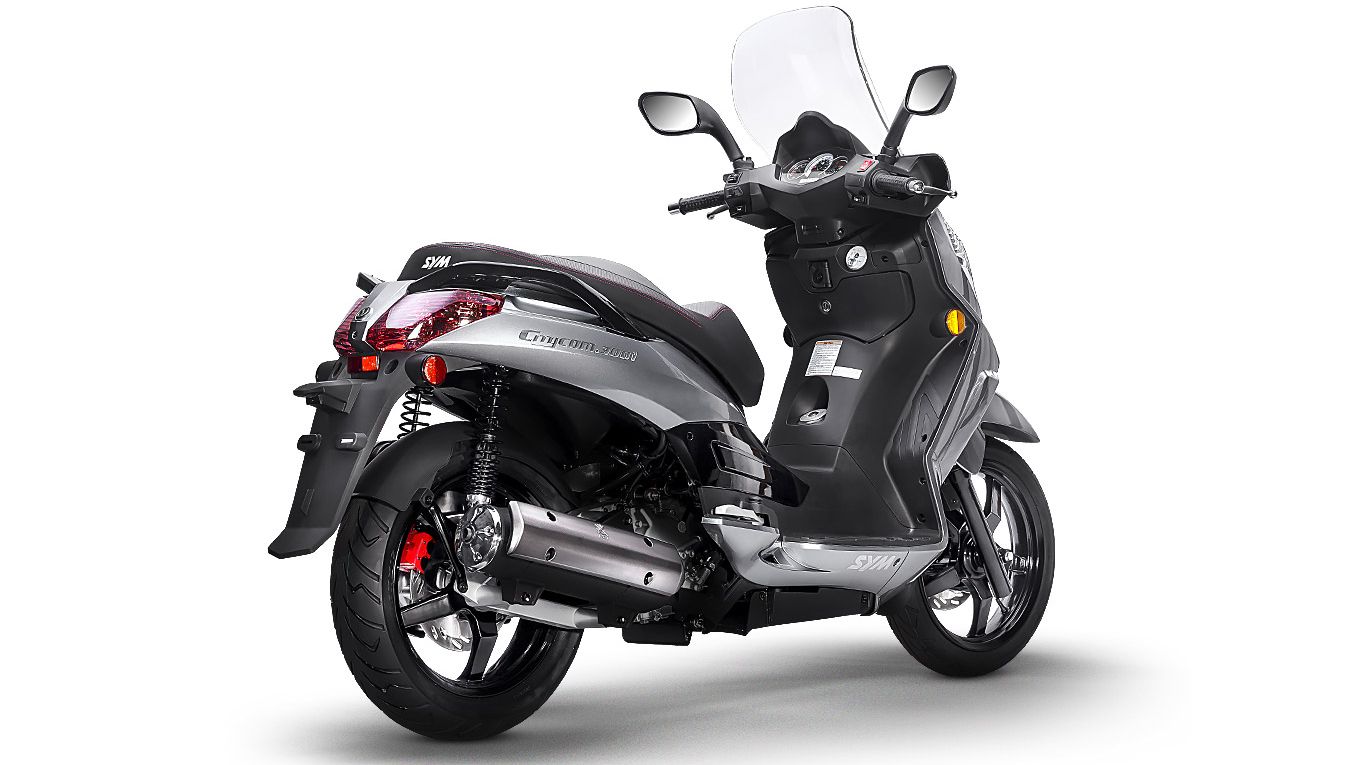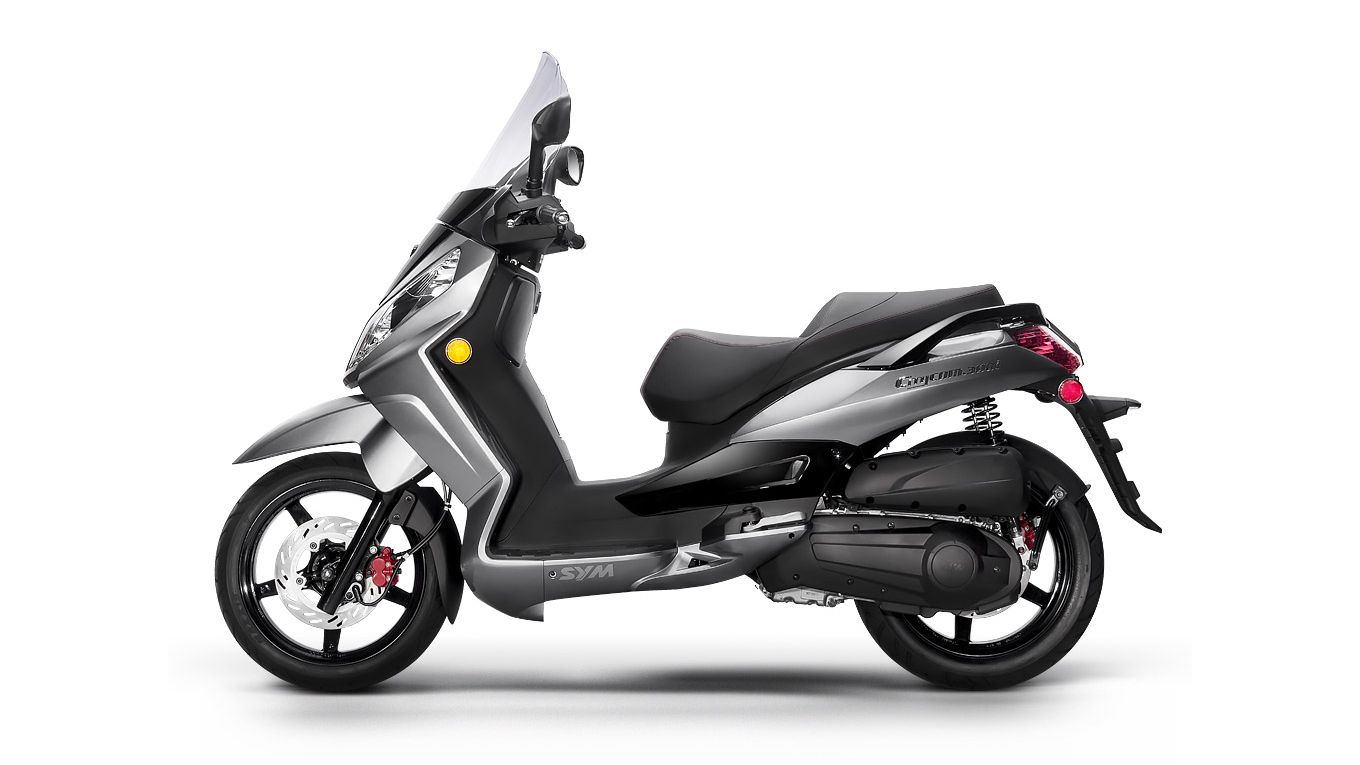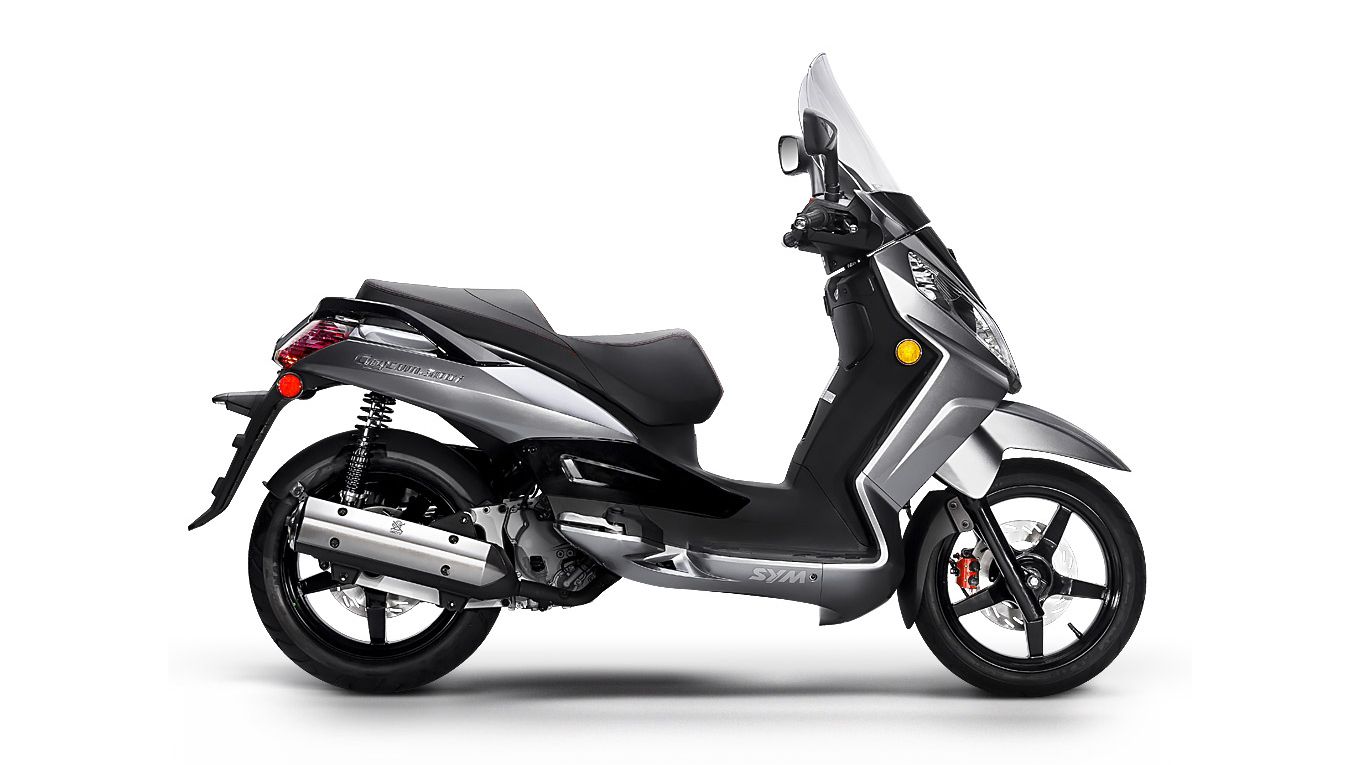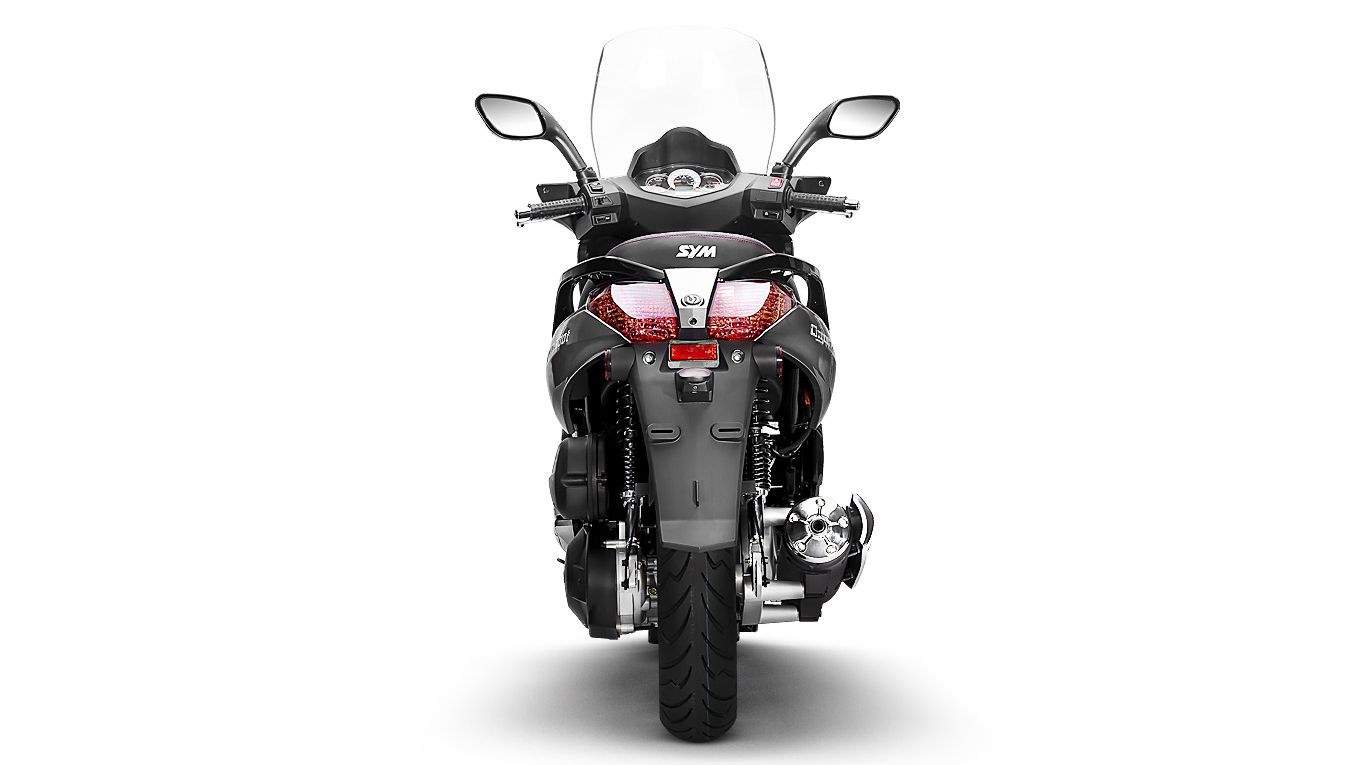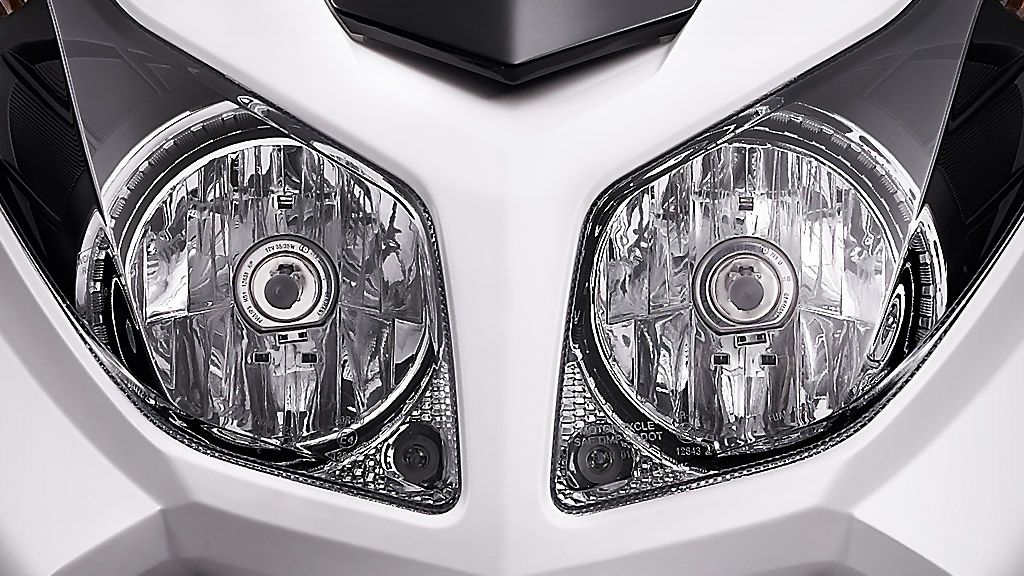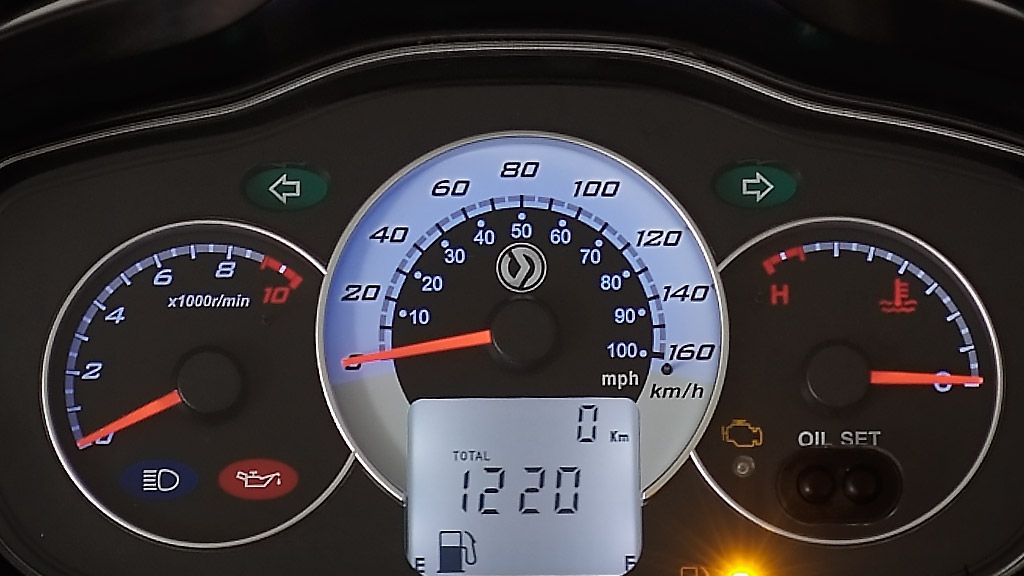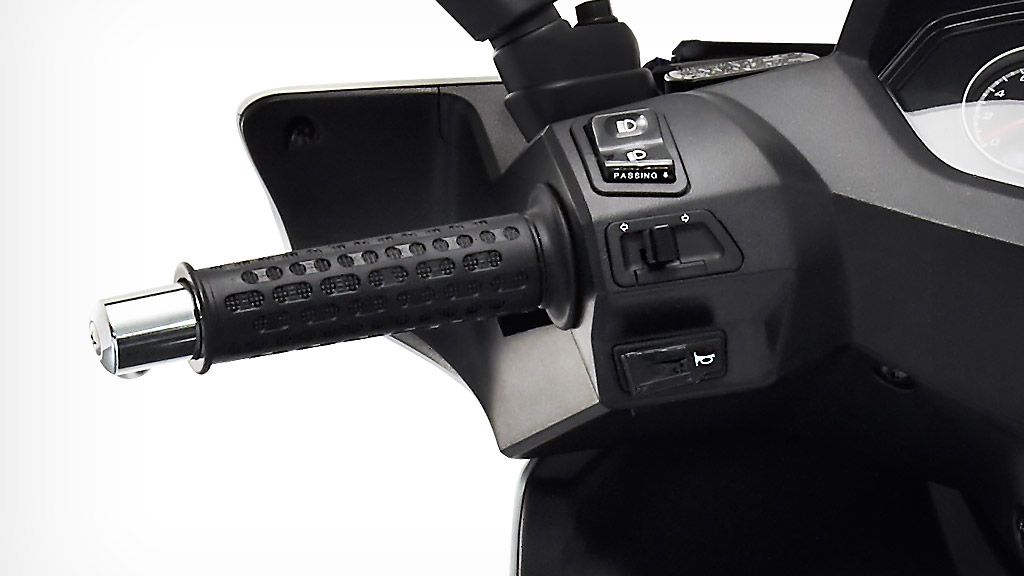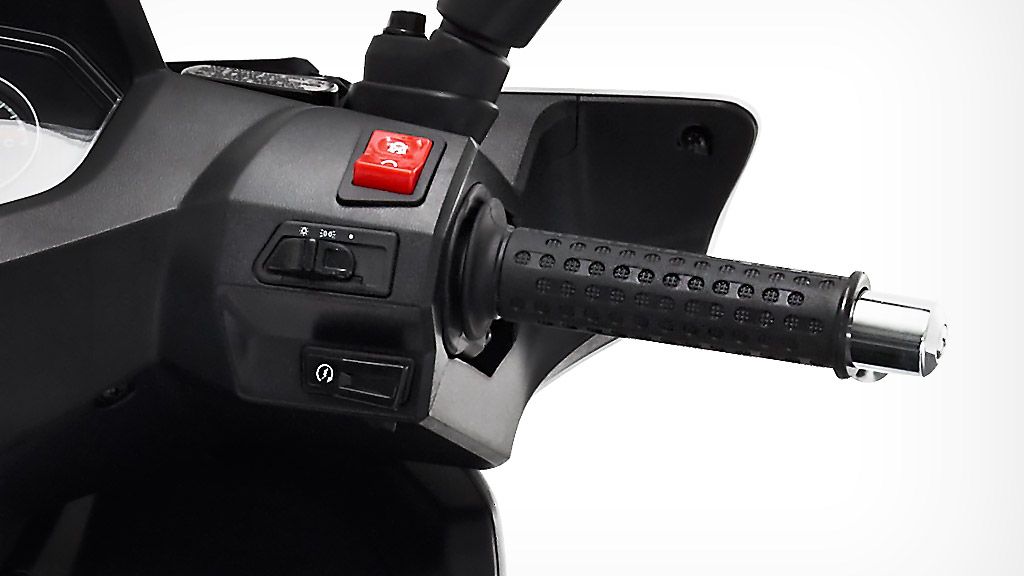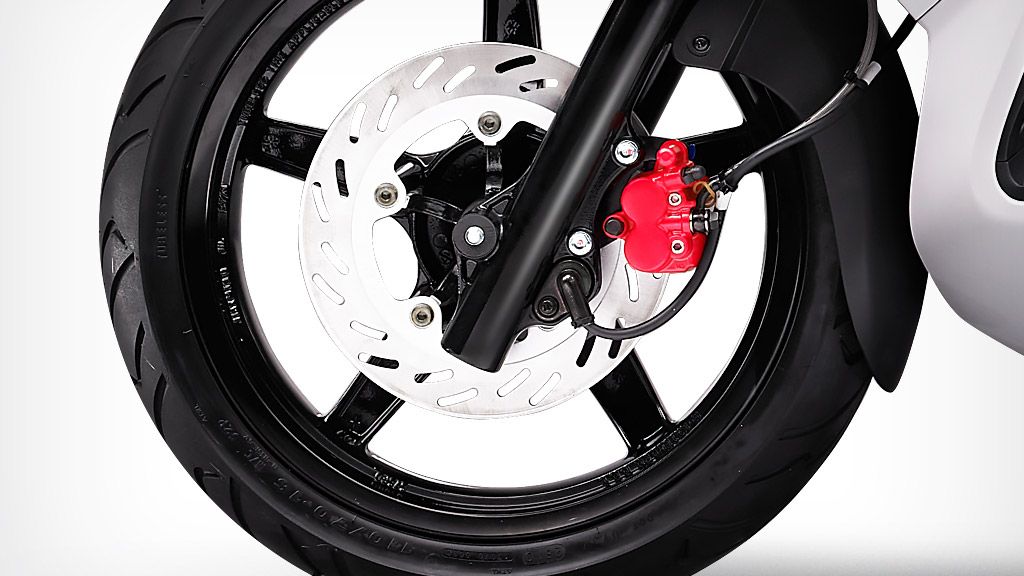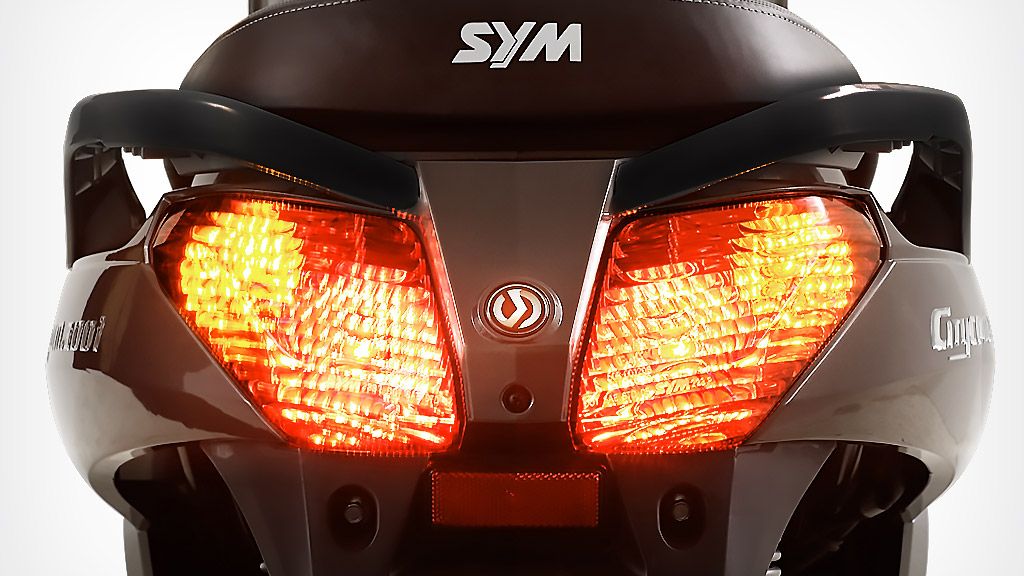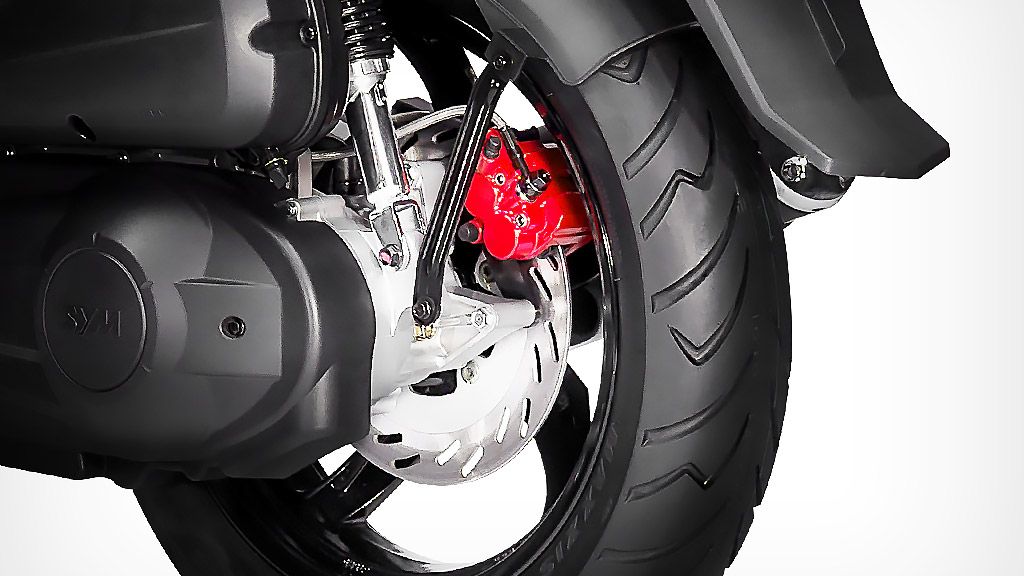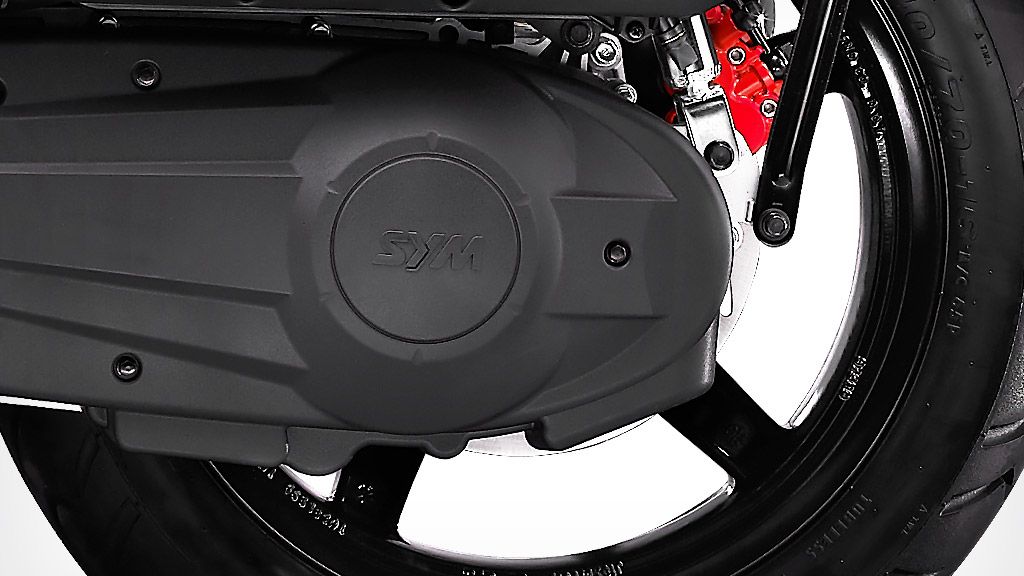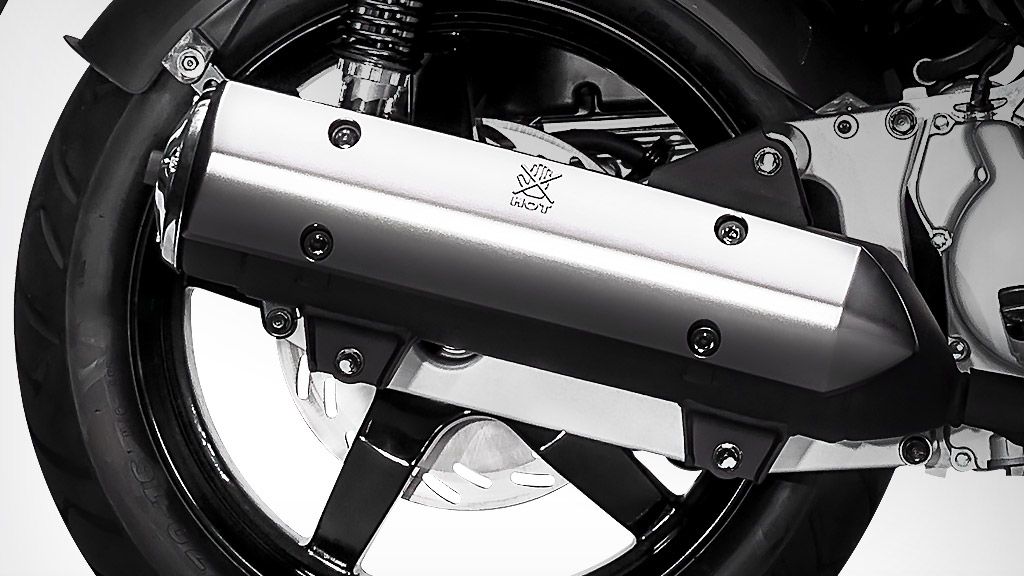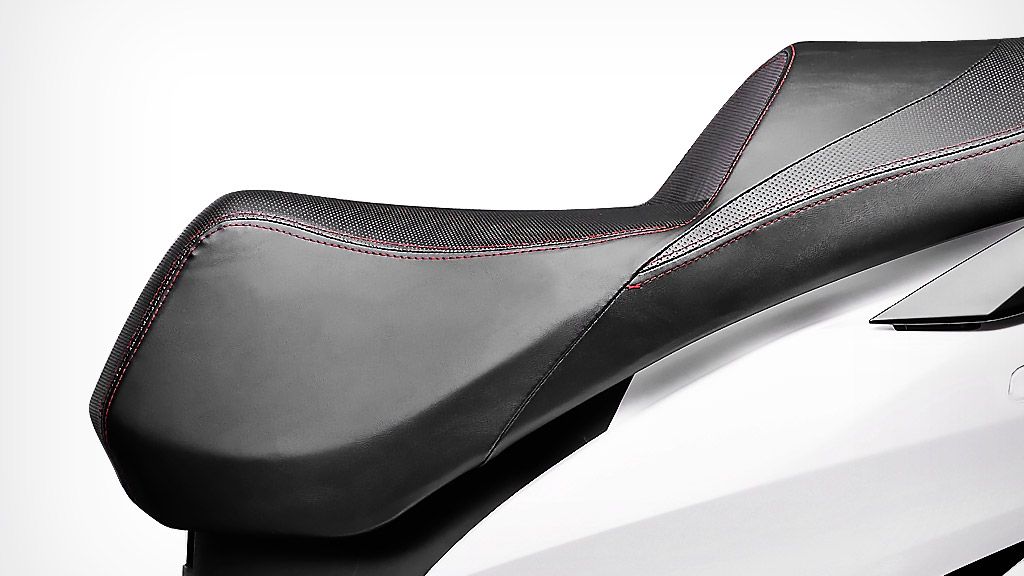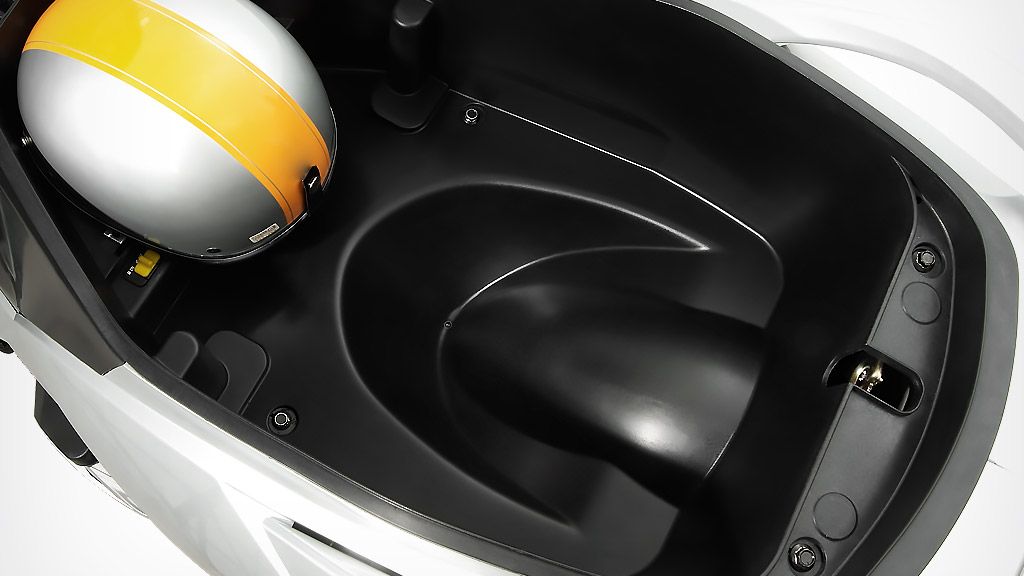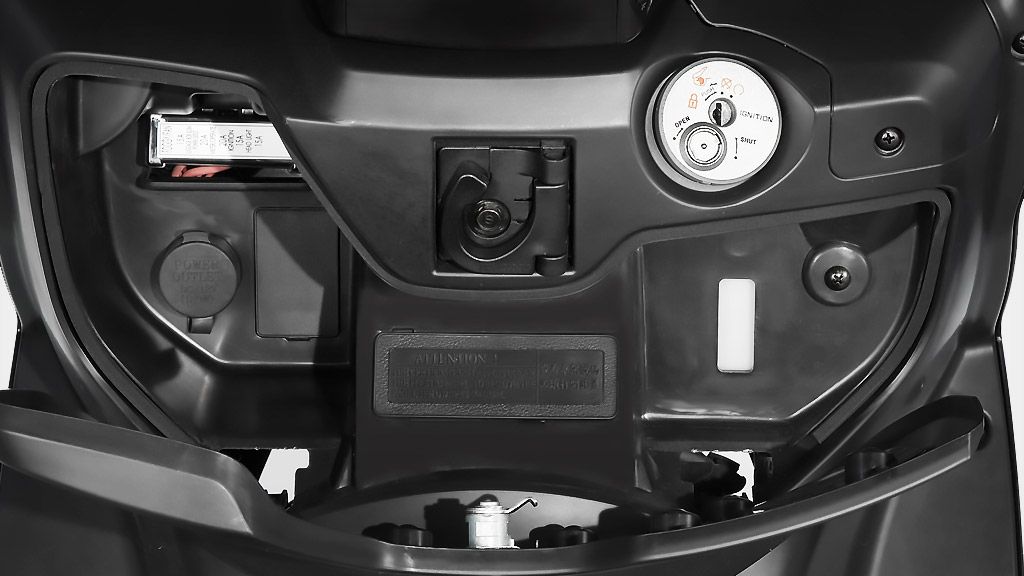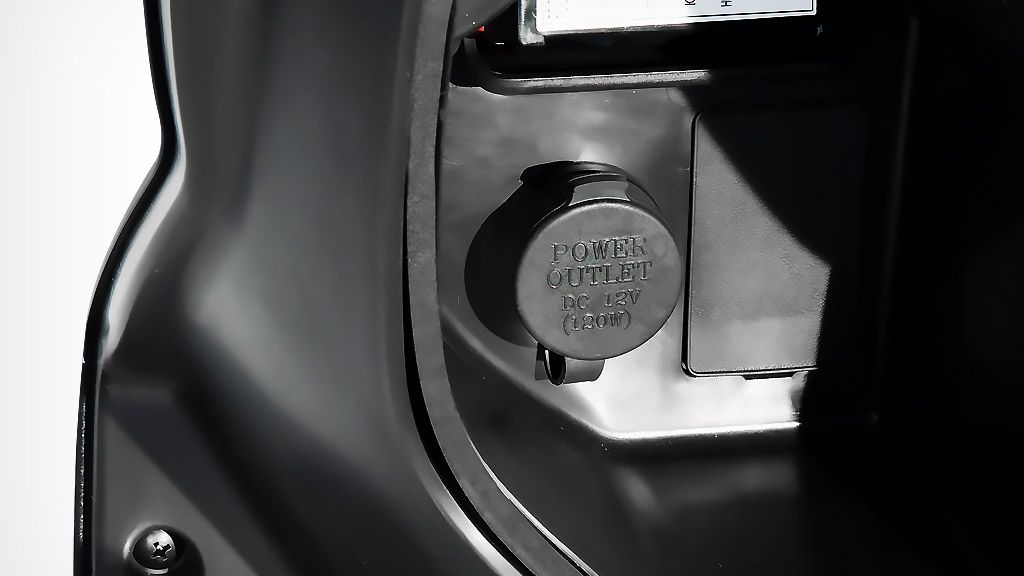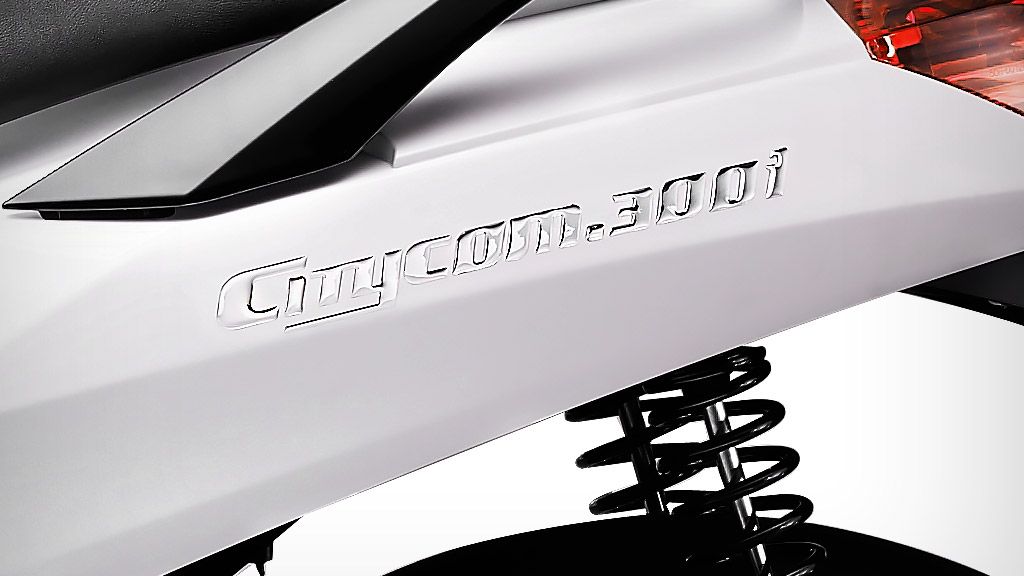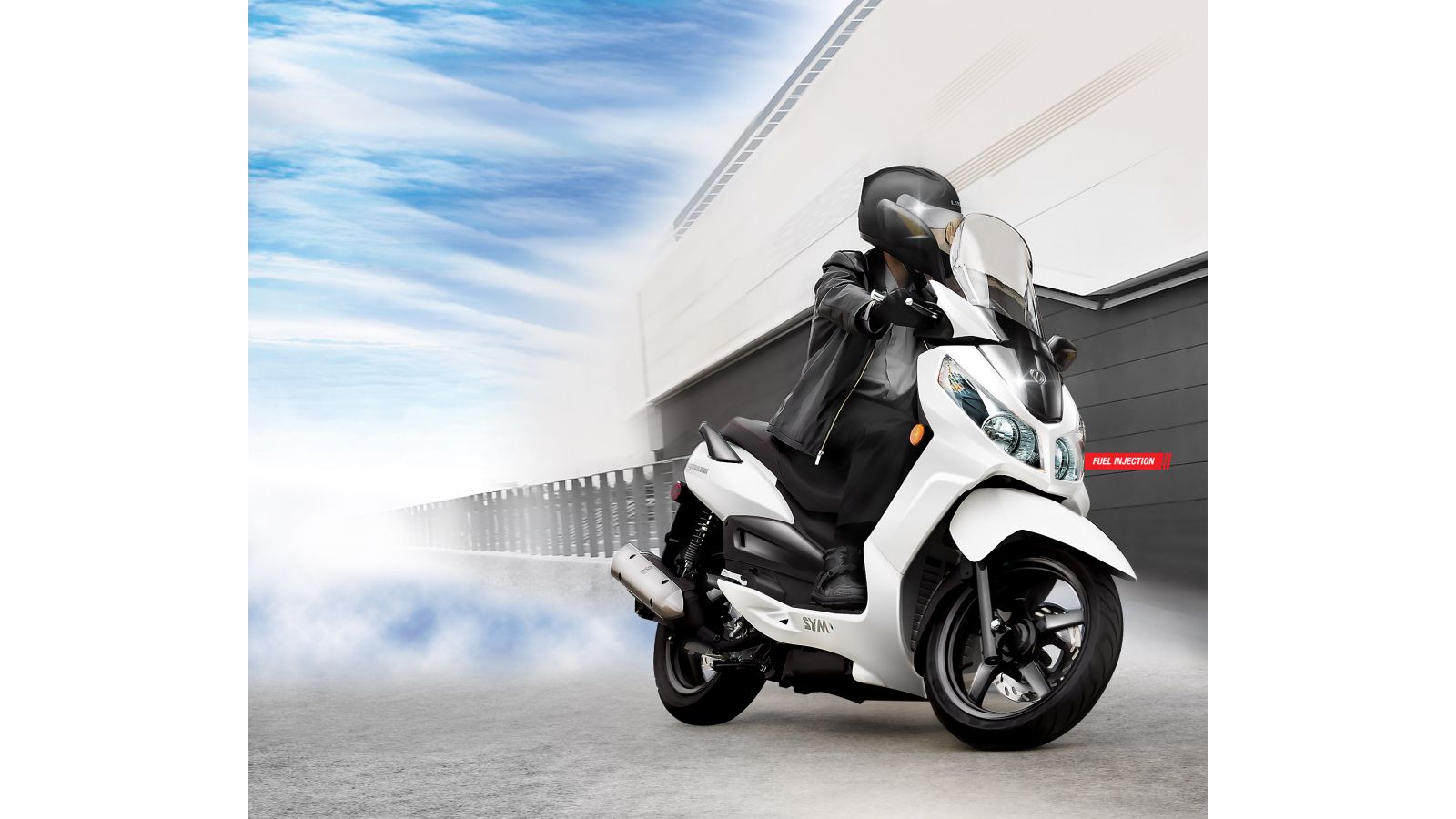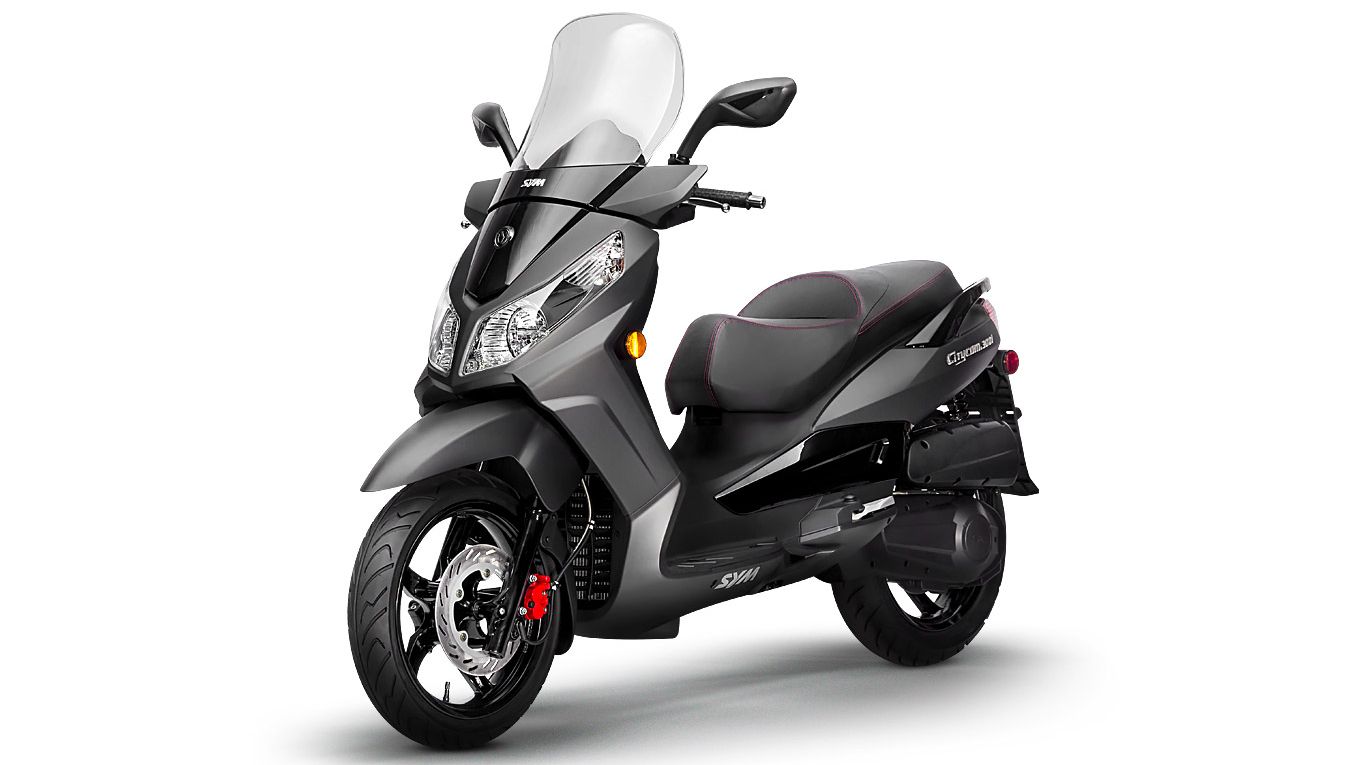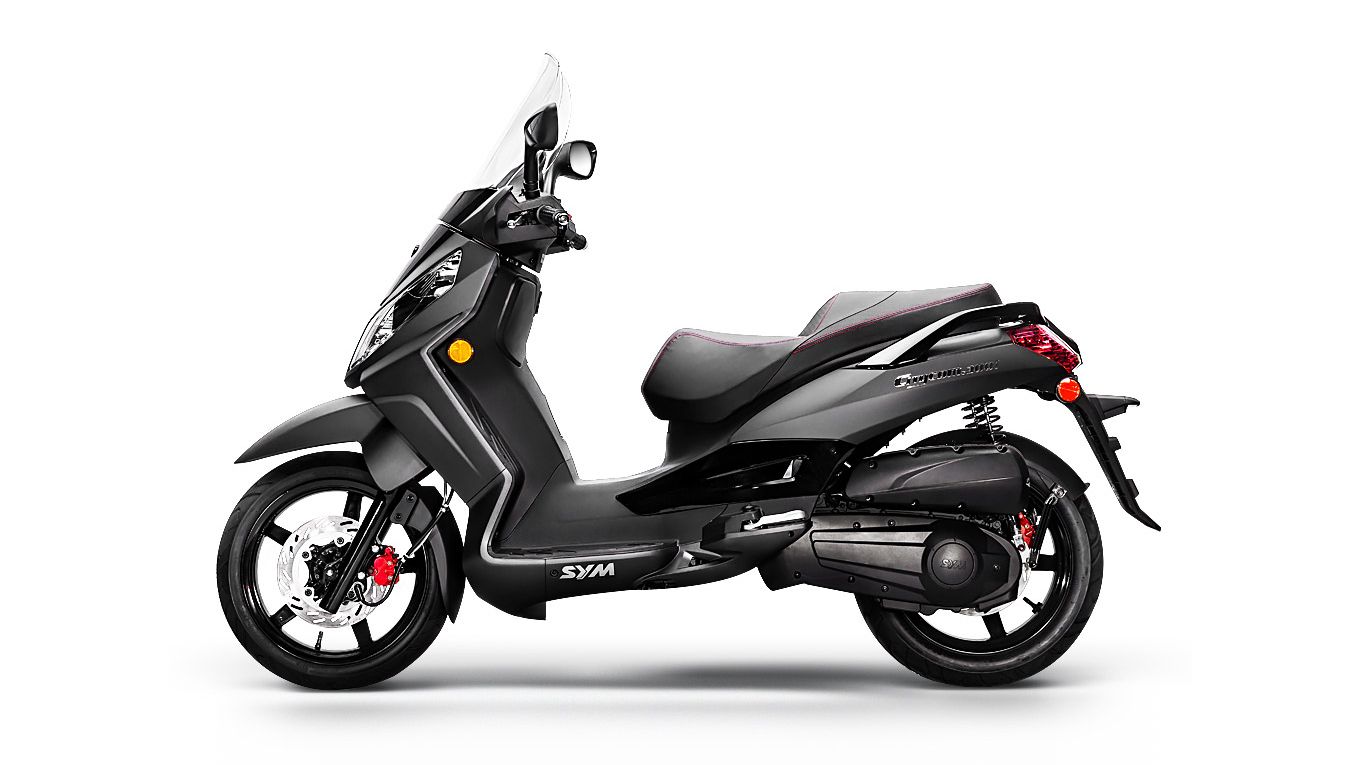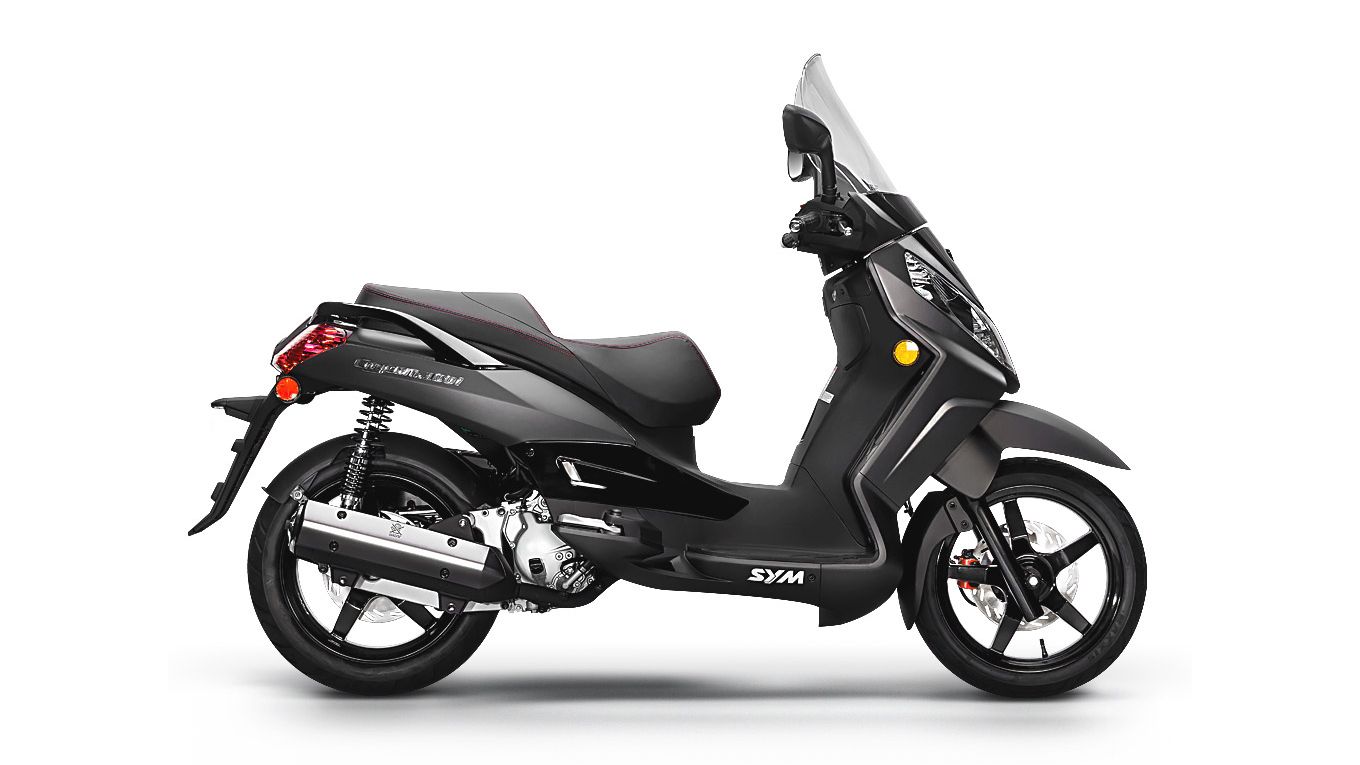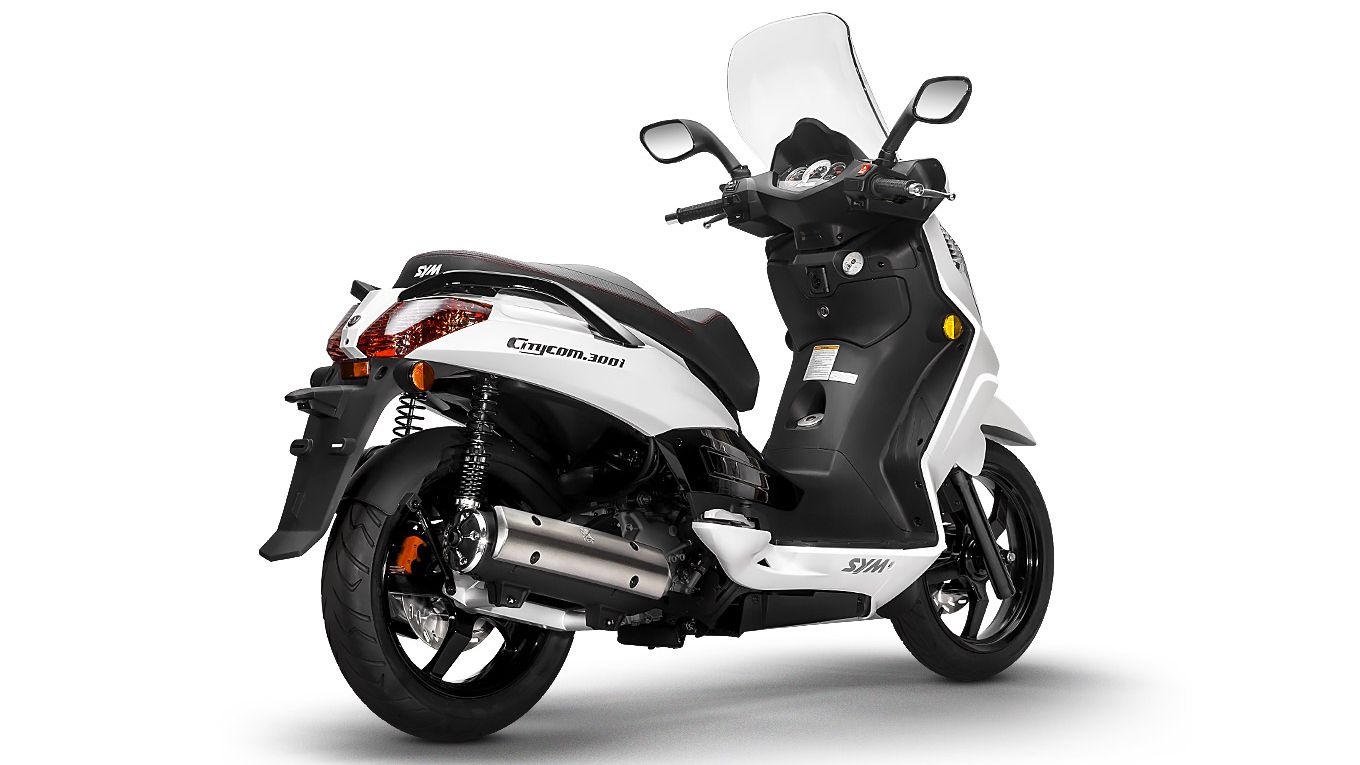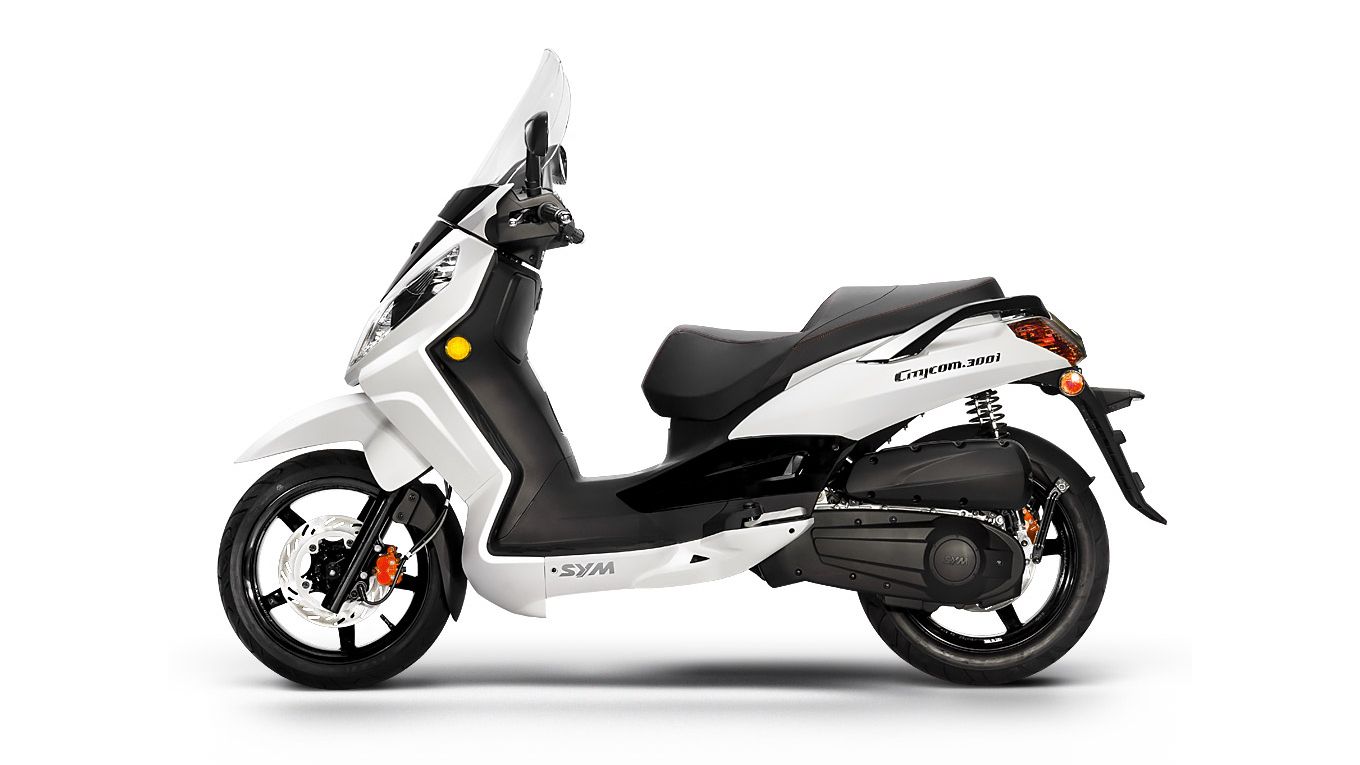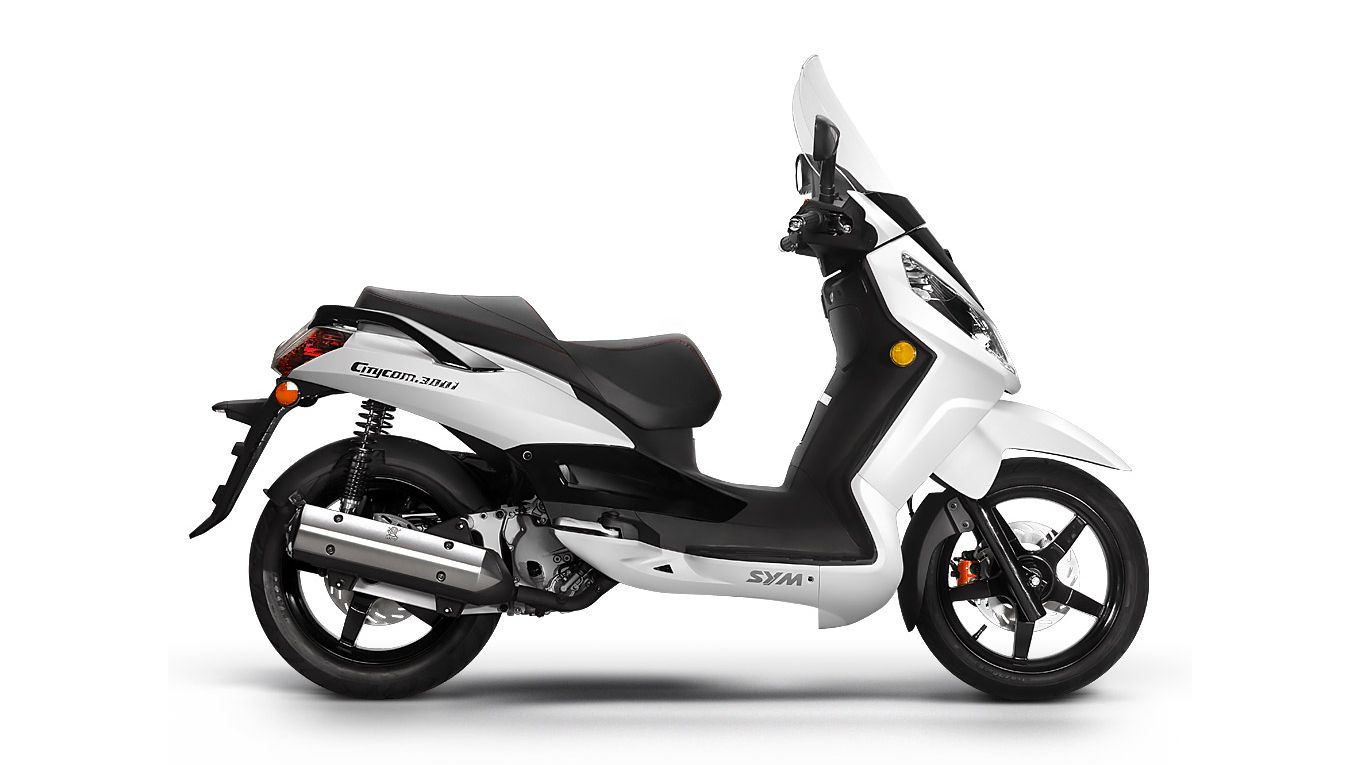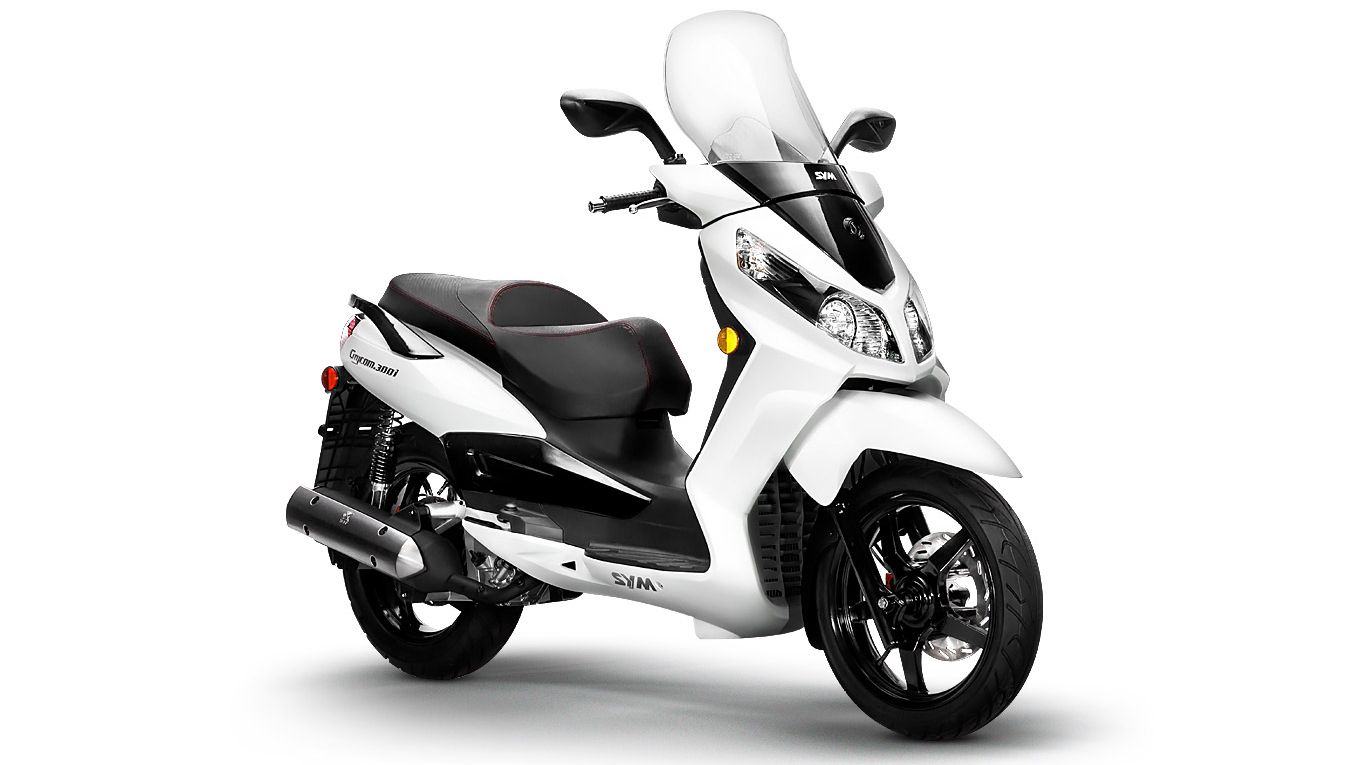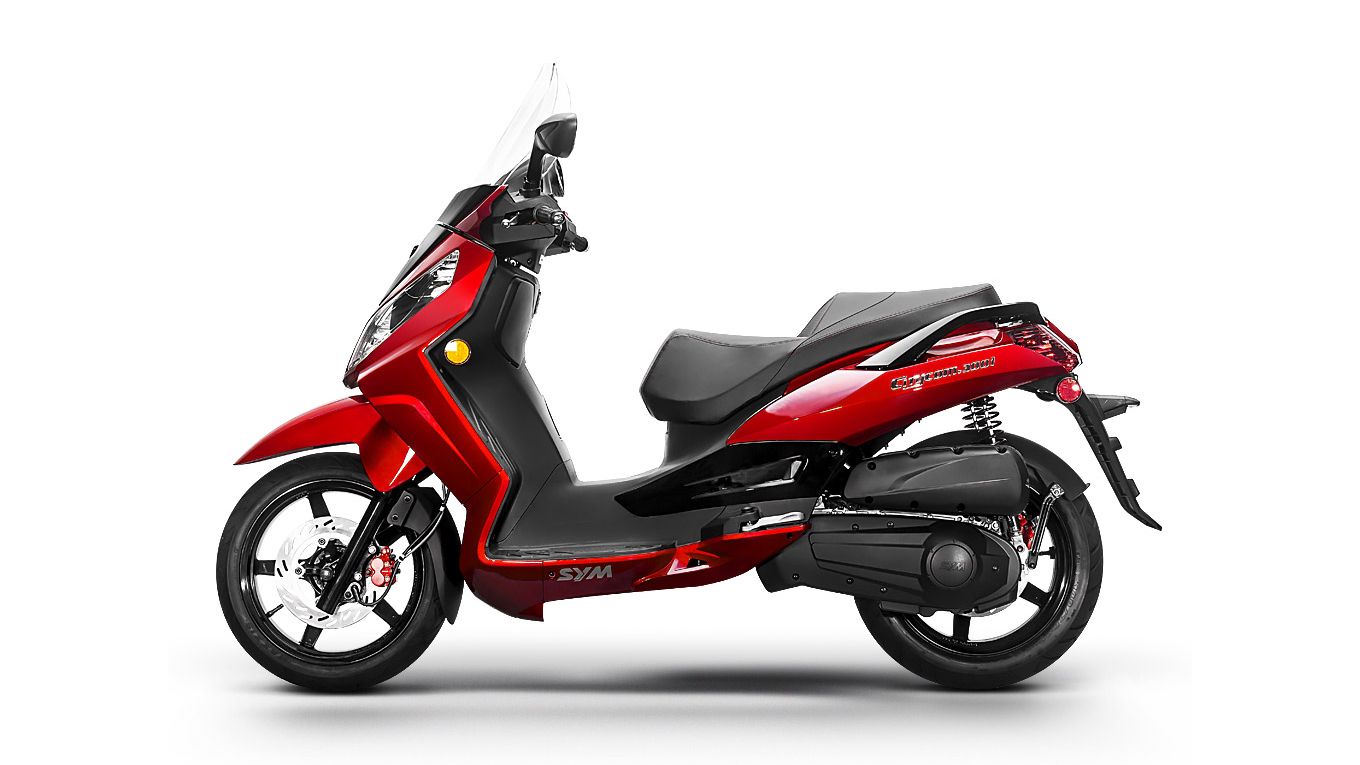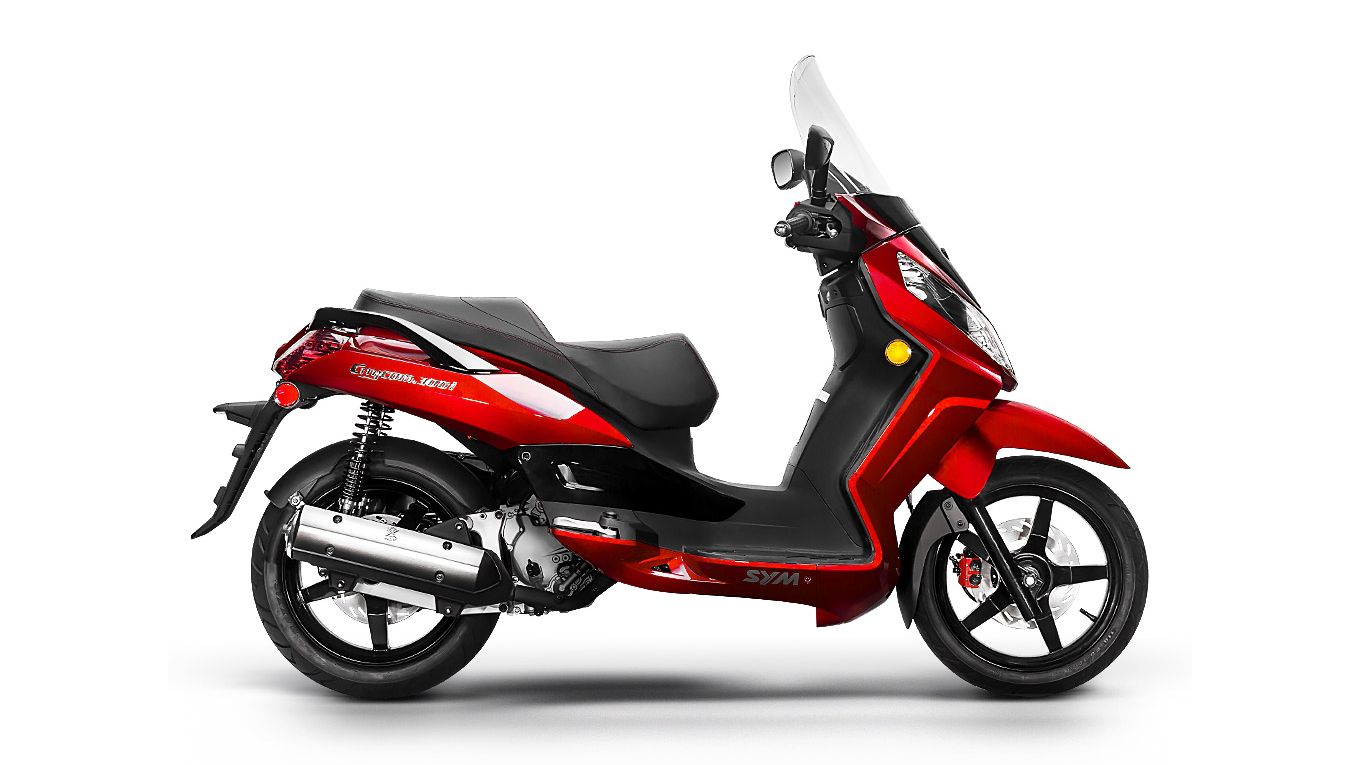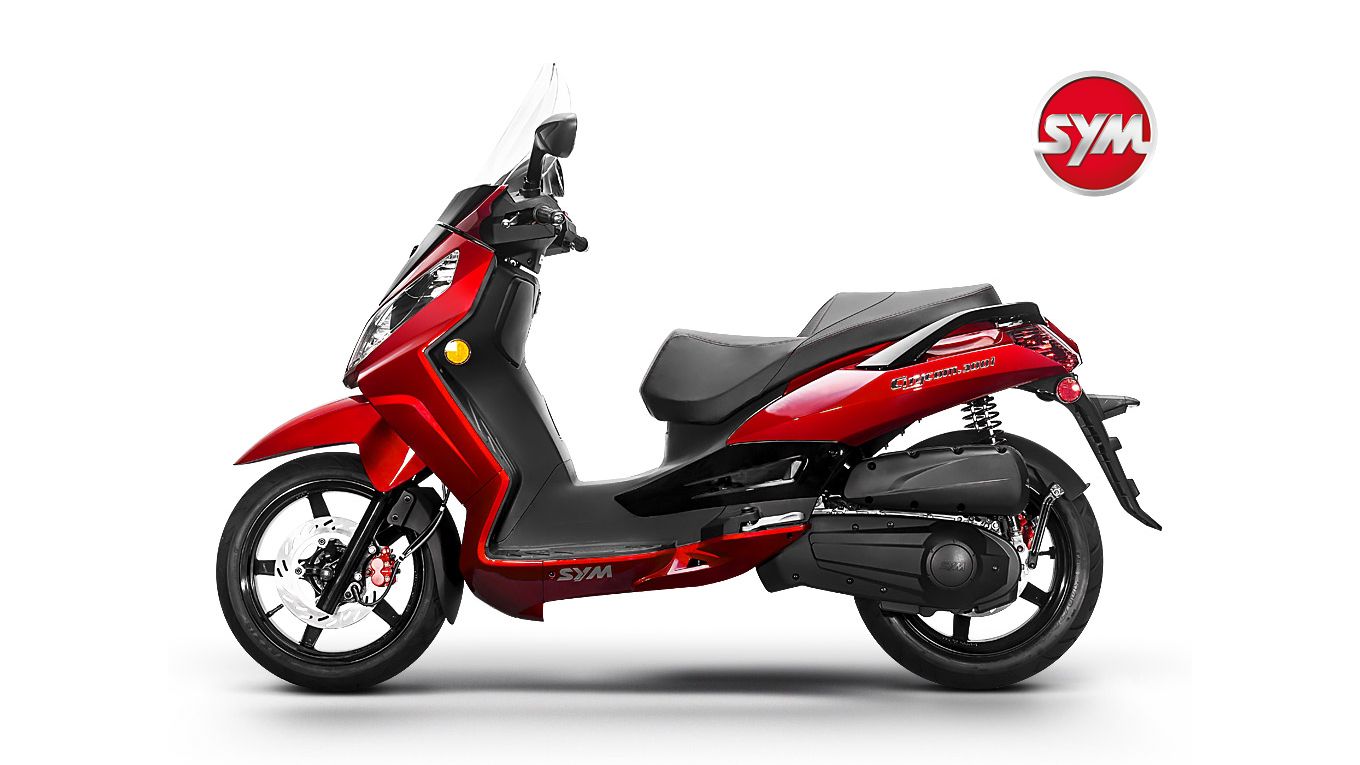In 2012, SYM introduced its first fuel injected model -- the Citycom 300i -- for the 2013 model year. Joining the ranks of big-wheel scooters->ke2256, the Citycom 300i sports 16-inch wheels for stability and smooth riding across town or up the highway.
A little differently blended for the North American market, the Citycom comes with a 263 cc engine -- not the 278 cc F4 engine in outside markets -- and comes with no linked or combined brakes here. I kinda wish it did, but so far that hasn't detracted much from what is a sporty-looking and sporty-capable ride.
Continue reading for my review of the SYM Citycom 300i.
2016 SYM Citycom 300i
- Make: Array
- Model: 2016 SYM Citycom 300i
- Engine/Motor: inline-1
- [do not use] Vehicle Model: Array
Design
Let's get the blahblah out of the way first. Yes, the Citycom has enough underseat storage to accommodate two helmets. Full face ones? I don't know. It'll fit one, but that's all I had. If you have two full-face helmets and can get them both inside the compartment, let me know. There's also a glove box for your bits and bobs. A nice feature that I'm seeing more and more of is a power socket inside the glove box and the Citycom has that. Plug your electronics in to charge while you ride or use the socket to power your GPS.
For your passenger, the Citycom is two-up friendly. The seat is plenty big enough for two butts, the scooter has fold-out footpegs and nice, big handgrips that extend out from the side of the pillion. For the passenger, this makes for a comfortable seating position and one that lets her control her balance herself and feel more secure rather than hanging on to you and bumping helmets the whole ride.
At a bit over 400 pounds plus rider, the Citycom is heavy enough to give a smooth ride and to hold its own through the slipstream. It has plenty of mid-range power and leaves you feeling confident off the line or during roll-on on the highway. The mirrors vibrate a little at speed, but otherwise give a good view of what's behind you.
The dual headlights provide ample visibility after dark -- both seeing and being seen -- and the instrument cluster holds nice, big, easy-to-read analog dials for tach, speedometer and coolant temperature. The smaller digital display holds the clock, odometer and fuel gauge. Dial gauges are my preference, but I know not everyone agrees.
The fuel filler cap is at the base of the tower above the step-through -- a much preferred position over having it under the seat. Not only do I have to unload all the gear I have bungeed on the pillion, but I risk splashing gas inside the storage compartment when the fuel filler is under the seat. I gladly give up the flat cargo area between my feet to have the fuel tank there instead.
My only downside, and it wasn't a downside for me at all, was the footboards. I was fine, but I wonder whether a taller person would feel a little cramped without room to slide his feet forward bit more.
Chassis
Sanyang built the Citicom over a tubular-steel under-frame; a much stronger, durable and repair-friendly system than the monocoque, “uni-body” assembly featured on so many rides. I prefer this system to the “stressed-skin” variety that uses the body panels as load-bearing members, and usually requires cutting and welding gear to repair even minor body damage. Between-feet storage in the stepthrough is one of the inherent possibilities with this setup, too bad SYM put just enough of a tunnel-bump to interfere with that extra little bit of convenience.
The symmetrical, cast-aluminum rims measure out at 16-inches in diameter, and come wrapped with a 110/70 tire up front and a 140/70 in back. This is well into proper motorcycle territory, and is a far cry from the dinky, go-cart-like tires you can find on some makes and models. Suspension is fairly typical with hydraulically damped, telescopic forks supporting the front end, and a pair of coil-over shocks to spring the rear off the swing-mount drive unit. While the forks are non-adjustable, the shocks come with a spring-preload adjuster. Brakes are samey-same as well with a twin-pot, piston-and-anvil caliper pinching 260 mm brake discs on both ends; an unusual setup that no doubt provides more braking power at the rear wheel than the usual drum brake or smaller disc, but I have to wonder if that's a little overkill considering 70% of your braking power is generated at the front tire, not the rear. Oh well, at least it's not a drum, but I do advise easing into that back brake until you get a feel for how grabby it's going to be.
Drivetrain
In spite of the “300” in its name, the beating heart of this little ride actually measures out a bit smaller at 262 cc. The liquid-cooled, four-stroke thumper runs a four-valve head with a generous squish zone that concentrates the fresh air-fuel charge around the centrally located spark plug, and drives the compression up to an even 10-to-1. Fuel injection helps the 300i meet EPA, DOT and CARB emission standards, and it delivers up to 64 mpg so the 2.64-gallon fuel tank gives this little scoot some fairly long legs. A ceramic coating in the cylinder helps reduce mechanical losses due to piston-to-cylinder friction, and this serves as a substitute for the old sleeve insert to help keep weight and machining costs down.
The engine cranks out 17.3 pounds of grunt at 5,500 rpm and 20.6 ponies at an even 7 grand, and the CVT transmission drives the Citycom up to 81 mph with effortless and idiot-proof, twist-and-forget riding.
Pricing
MSRP on the made-in-Taiwan SYM Citycom 300i is $4,999. For 2016, choose from Matte White, Matte Black, Chili Red, or Titanium Gray. SYM covers your ride with a 24-month limited warranty.
Competitors
Since SYM and Honda->ke291 have had such a long working relationship, I decided to take a look at what the Red Riders had going on over there for my comparison. I didn't have long to look before I found just what I was looking for in the Honda Forza.
The Honda sports the same sort of Euro-style features that grace the Citycom, but it takes them to a more sophisticated level. A deep fairing makes the Forza front end look more substantial, and the molded windshield gives it a sort of sport-tour panache. At 28.2-inches tall, the Forza falls well short of the 31.5-inch seat height on the Citycom, but that shortness of height actually makes the Forza look longer than it actually is.
To their credit, both manufacturers stick to the under-frame style chassis, and both run wet front forks and dual rear shocks, with no differences worth mentioning in the suspension. That changes when we look at the brakes, however. While the Citicom runs plain vanilla in the binder department, the Forza comes with a Combined-Brake System (CBS) that sends pressure from the rear brake to a dedicated piston in the front caliper for somewhat balanced braking as standard equipment, with ABS as an available option. Too bad Honda had to opt for a 13-inch rear, and 14-inch front tire in order to get its low seat height, 'cause I really like the 16s on the Citycom.
Much like the rest of the ride, the beating hearts have more in common than not. Both single-cylinder engines run with liquid cooling and four-valve heads, and both shun carbs in favor of fuel injection. Honda does pack in a few more cubes for a total of 279 cc, just 17 more than the Citycom, and it shows its experience with small engine manufacturing with 24.5 horsepower and 19.5 pound-feet of torque versus the Citycom with only 20.6 horsepower and 17.3 pound-feet.
SYM gets a minor victory at checkout with a $4,999 sticker versus the $5,599 tag on the Forza, but its a hollow victory. When you're already looking at a five-grand pricetag, a few huudred more can be a drop in the bucket to get more sophisticated tech alphabet soup acronyms included.
versus0}
My husband and fellow motorcycle writer, TJ Hinton, says, “I'd love to find something nice to say about the Citycom 300i, but it's just so middling, so typical. Nevermind that for that price, you could score a real motorcycle, and for another grand or two get something that you won't be embarrassed to be seen on. I can't help but feel that many riders will probably outgrow this scooter fairly quickly unless they are limited to scooters for licensing reasons.”
He Said
“I very much disagree with my husband on this. It's a spiffy little scooter. It's big enough for the highway so you don't get sucked under a passing truck, but also gets decent gas mileage. It's big enough and small enough in all the right places. If you want a motorcycle, you'd be looking at a motorcycle. The simple fact that someone would be researching a 300 cc scooter tells me that person wants the convenience of a scooter.”
Specifications
|
ENGINE / DRIVE TRAIN: |
|
|
Displacement: |
262 cc |
|
Type: |
4-Stroke Engine, Fuel Injection System with 4 Valve Ceramic-Coated Cylinder |
|
Compression Ratio: |
10.0 : 1 |
|
Horsepower: |
20.6 hp - 7000 RPM |
|
Max Torque: |
17.3 lb/ft - 5500 RPM |
|
Cooling System: |
Liquid |
|
Transmission: |
C.V.T. |
|
Clutch: |
Centrifugal, Dry Type |
|
Drive: |
Belt |
|
Starter: |
Electrical Starter |
|
Ignition: |
ECU |
|
Spark Plug: |
NGK CR 8E |
|
Battery Capacity: |
12V 12Ah |
|
Top Speed: |
81 mph |
|
CHASSIS / SUSPENSION / BRAKES: |
|
|
Frame: |
High Strength Steel |
|
Front Suspension: |
Telescopic Fork |
|
Rear Suspension: |
Unit Swing |
|
Front Brakes: |
Disc (260 mm) |
|
Rear Brakes: |
Disc (260 mm) |
|
Front Tires: |
110 / 70-16 52P tubeless |
|
Rear Tires: |
140 / 70-16 65P tubeless |
|
Wheel: |
Aluminum |
|
CAPACIITIES / DIMENSIONS: |
|
|
Weight Capacity: |
364 Lbs |
|
Net Weight: |
405.7 Lbs |
|
Fuel: |
Unleaded (90 Octane or Higher) |
|
Fuel Capacity: |
2.64 Gallons |
|
Ground Clearance: |
4.9" |
|
Length: |
87" |
|
Width: |
30.9" |
|
Height: |
56.9" |
|
Seat Height: |
31.5" |
|
Wheelbase: |
59.0" |
|
Age Recommendation: |
16+ |
|
ADDITIONAL INFO: |
|
|
Government Certifications: |
EPA & DOT Approved, C.A.R.B. Approved for CA |
|
Warranty: |
Made in Taiwan with 24 Months Limited Warranty |
|
MPG: |
64 MPG |
|
AVAILABLE COLORS |
Matte White, Matte Black, Chili Red, Titanium Gray |
|
MSRP |
$4,999 |


